]]>
A record crowd of more than 200 attended the fifth annual Scientific Symposium hosted Sept. 5 by USF and the Friedreich’s Ataxia Research Alliance  (FARA).
There was standing room only as clinicians, researchers, patients and their families and friends gathered at the USF Health Center for Advanced Medical Learning and Simulation to learn about the latest advances in ataxia research. The live audience was bolstered by those from across the world who viewed the symposium livestream through the FARA Facebook page — more than 450 views were recorded.
Many symposium attendees were among the more than 800 friends of the USF Ataxia Research Center and FARA who attended the annual FARA Energy Ball Saturday, Sept. 7, raising more than $1.7 million in donations and in-kind gifts for both organizations.
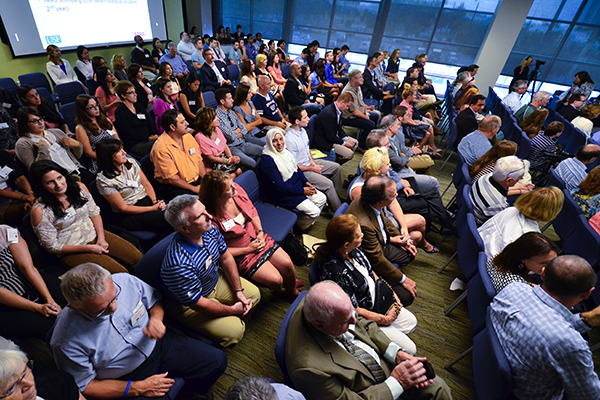
The collective efforts are producing results. This past year, FARA helped hundreds of patients become part of four new treatment trials, including the Edison Pharmaceutical-sponsored national EPI-743 trial led by USF neurologist Dr. Theresa Zesiewicz, director of the USF Ataxia Research Center. Findings from stem cell and gene therapy studies are giving researchers a better understanding of Friedreich’s ataxia in the drive toward a first treatment, and ultimately a cure, for the progressive, life-limiting neuromuscular disease.
Here are some highlights from this year’s symposium speakers:
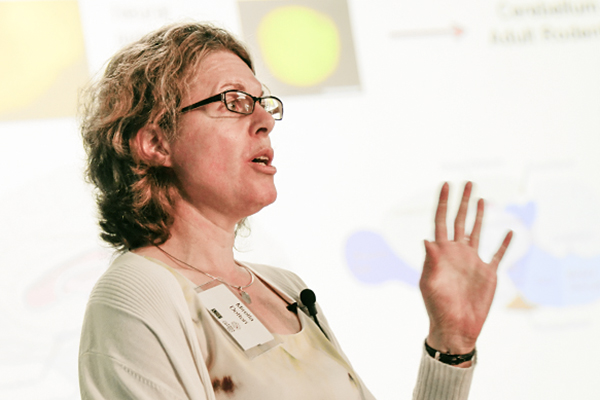
Mirella Dottori, PhD, principal investigator and senior research fellow at the Centre for Neuroscience Research, University of Melbourne, Australia. Using skin cells from Friedreich’s ataxia patients converted into pluripotent stem cells, Dr. Dottori’s team recently induced these stem cells to generate the specific cell types that degenerate in Friedreich’s ataxia, including heart and nerve cells.
“In the stem cell field, we have to work on all aspects. It’s critical that we still improve methods of generating patient-derived stem cells. It’s critical that we work on how we move from a stem cell the end-cell lineage that we need. It’s critical to work on how to use these stem cells for drug discovery. It’s critical to understand how to correct a mutation, ultimately for the transplantation of stem cells. A lot of research groups…are all working together on these different aspects to bring everything together. What we’re aiming for, always, is a cure — if not at least a treatment — and I think it’s feasible with all these approaches.â€
Theresa Zesiewicz, MD, professor of neurology and director of the USF Ataxia Research Center, who reported on five clinical trials the center is conducting for patients with FA.Â
“This is a symposium where we come together as community, and it’s important that we all come together as one. Because, as (FARA’s) Ron Bartek said, alone we can do nothing, but together we can do everything.â€

Guy Miller, MD, PhD, CEO of Edison Pharmaceuticals, Inc. Dr. Miller spoke about Edison’s quest for the first successful neuroprotective drug, including lessons learned in the development of the powerful antioxidant EPI-743 for Friedreich’s ataxia, now in a national Phase 2B clinical trial.
“The truth is we have lots of failure in drug development for neurogenerative disease. This process is no easier than a landing on the moon challenge…The first step is critical, and we believe that Friedreich’s ataxia is going to be the disease that sets forth in motion the key learning.â€
“The ability to sequence your genes and understand what errors in DNA might lead to disease, the proteins that come from that, and ultimately the metabolites that regulate those proteins. We’re (Edison) interested in how that whole choir sings together, and we call that redox control.â€
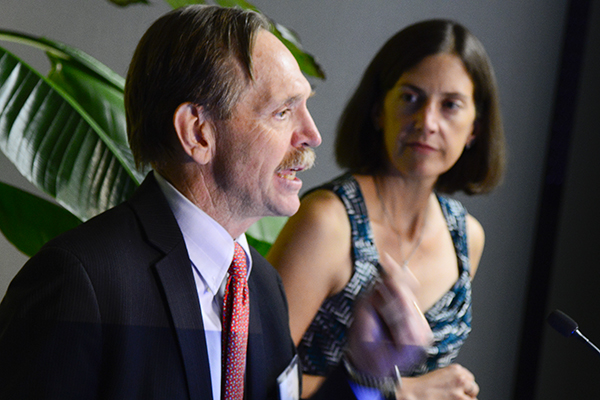 Â
Â
Jennifer Farmer, FARA executive director
“We hope those of you present here feel the momentum and progress toward changing the future of FA that Ron (Bartek) and I see.â€
Ron Bartek, FARA president
“We need to continue to work together, with your participation and generous support… to push these clinical trials across the finish line – to get that first approved treatment that is so important.â€
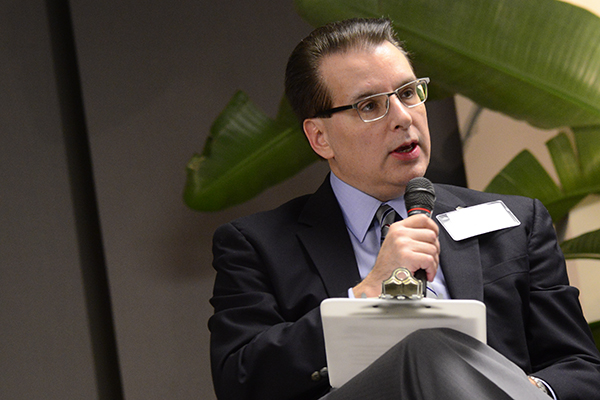
Clifton Gooch, MD, professor and chair of the USF Department of Neurology
“What we’ve seen in the five-year trajectory of this symposium is a locomotive gaining steam… We’ve entered the era of a therapeutic revolution in Friedreich’s ataxia… We’re at a great threshold… What we do (today) to improve the lives of patients with FA and make strides toward eradicating this disease will be remembered in the future. We need you, the patients and families, to continue to fight the good fight with us, but some day, I’m convinced, we will win this battle.â€
 Â
Â
Lealan LaRoche, diagnosed with Friedreich’s ataxia at age 20. LaRoche spoke as part of a patient panel discussion moderated by Dr. Gooch. She holds master’s degrees in architecture and city planning.
“Being diagnosed with this debilitating disease made me realize that designing for people who are disabled and abled together could be a great thing.â€
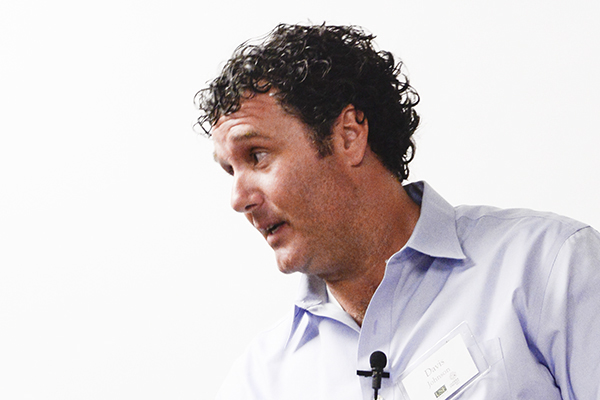
Davis Johnson, diagnosed with FA at age 40. Johnson, a patient on the panel, participated in multiple sports and played football in college. He has a 10-year-old son.
“My diagnosis has made me more patient. I used to live life to the fullest, go places, travel. Now I have to think about getting dressed, eating…everything I do requires some help…. But, being part of the studies and this symposium, and seeing all the people trying to find a cure, gives me hope.â€

Participating in the patient discussion of living with Friedreich’s ataxia were, left to right, Natchez Hanson, Davis Johnson, Lealan LaRoche and Kyle Bryant.
Within the past five years, the multidisciplinary USF Ataxia Research Research Center has become one of the busiest clinical trial centers worldwide for new and experimental approaches to Friedreich’s and other ataxias.
The clinical trial testing the potential Friedreich’s ataxia drug EPI-746 has enrolled its full complement of 60 patients at three sites – UCLA and Children’s Hospital of Philadelphia as well as USF. Results of the trial are expected to be presented at next year’s symposium.

Staff and volunteers from the Friedreich’s Ataxia Research Alliance respond to queries from the online audience watching the symposium via livestream.

Symposium participant Regina Russo shows some muscle in her support of the fight against Friedreich’s ataxia.


Photos by Eric Younghans, USF Health Communications
Â
]]>
]]>
Natchez Hanson considers one of her proudest accomplishments walking across the stage to receive her college diploma – earning a bachelor’s degree in math education.  Hansen, 24, now a high school math teacher in Polk County, lives daily with the challenges of Friedreich’s ataxia.
Friedreich’s ataxia, a rare debilitating neuromuscular disease, typically strikes between the ages of 5 and 15, causing vision, balance, speech and cardiac problems and progressively robbing a young person of their energy, strength and ability to walk.
While physical therapy helps Hanson work on core strength and balance, there is no approved treatment for Friedreich’s. That’s why she is so excited to be part of a USF-led national clinical trial of a drug that researchers, clinicians and patents hope will be the first to improve the symptoms of the life-shortening disease.

USF Health neurologist Dr. Theresa Zesiewicz, left, with patient Natchez Hanson, one of the participants in the USF-led national clinical trial for a potential Friedreich’s ataxia drug.
“I don’t want anyone else to feel the way I did (when I was diagnosed) if they don’t have to,†Hanson said. “I just cried because it was scary. A lot of people died being really young, and I was only 17.  I had all these dreams… I just wanted to be normal.â€
The double-blind, placebo-controlled trial, sponsored by Edison Pharmaceuticals, Inc., in collaboration with the Friedreich’s Ataxia Research Alliance (FARA), is led by neurologist Dr. Theresa Zesiewicz, director of the USF Ataxia Research Center.
Researchers are primarily testing the effectiveness of the investigational drug EPI 743, a potent antioxidant, on vision, in patients with Friedreich’s ataxia, many of whom experience varying degrees of visual changes. Secondarily, the study will evaluate neurological function.
Sixty patients with a genetically-confirmed Friedreich’s ataxia diagnosis have been enrolled in the study, which involves Children’s Hospital of Philadelphia at the University of Pennsylvania and UCLA in Los Angeles, CA, as well as lead site USF.
When the study was announced at last year’s USF/FARA Scientific Symposium, the news was welcomed with cheers and tears by patients and their families who had come to learn about the latest advances in ataxia research.
The reaction and subsequent overwhelming international interest by prospective trial participants did not surprise Dr. Zesiewicz and others who care for those with Friedreich’s ataxia.
“These are young people – children, teens, young adults – affected by a relentless disease that can cause early death,†said Dr. Zesiewicz, USF Health professor of neurology. “There is a real sense of urgency to find a first treatment … We’re racing against time here.â€
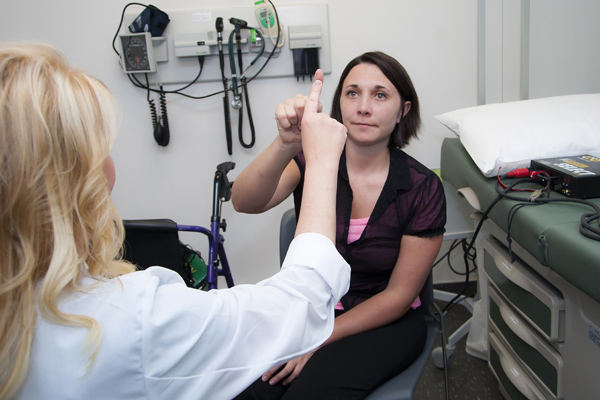
EPI-743 isn’t the only drug in the pipeline for Friedreich’s ataxia and related disorders, but it has shown promise in some early, limited trials —  including a study showing neurological benefit in children with Leigh syndrome, a mitochondrial disease, like Friedreich’s, that attacks energy metabolism.  And, so far at least, the drug appears to be well tolerated.
EPI-743 is an extremely powerful antioxidant — much stronger than the vitamin E you can get at a drugstore, Dr. Zesiewicz said. “The thinking is that this very powerful antioxidant will work on the energy-producing part of the cell, the mitochondria, to improve symptoms.â€
While Friedreich’s ataxia is the focus of the USF-led study, Dr. Zesiewicz said, “EPI-743 may have implications for other neurodegenerative disorders like Parkinson’s disease and Alzheimer’s disease.â€
USF is one of 10 partners in the FARA Collaborative Clinical Research Network, an international network of centers sharing and resources to advance treatments and clinical research for people with Friedreich’s ataxia.
The USF Ataxia Research Center conducts several studies in addition to the EPI-743 trial, including a clinical study on cardiac dysfunction in Friedreich’s ataxia and another looking for biomarkers to better monitor disease progression.
Edison Pharmaceuticals CEO Dr. Guy Miller, said USF was the logical choice to take the lead role in the latest EPI-743 trial.
“Many centers have silos of excellence in basic science, or clinical research, or translational research, but at USF there is a cross-section of excellence in all three, which is essential for conducting a well-run 2B clinical trial. †Dr. Miller said. “You also have a fantastic alignment of physician leaders who are innovative and care deeply about patients.â€

L to R: Dr. Stephen Klasko and Dr. Zesiewicz with Dr. Guy Miller, CEO of Edison Pharmaceuticals, at last year’s USF/FARA Scientific Symposium, where Dr. Miller announced the EPI-743 clinical trial for Friedreich’s ataxia. Dr. Miller returned to this year’s symposium, giving an update on drug discovery innovation and progress.
Dr. Clifton Gooch, chair of USF Health Neurology and director of the USF Neuroscience Collaborative, emphasized both the rapid rise of the center and the prospects for EPI-743.
“The USF Ataxia Research Center has become a leading international clinical trials center in just a few short years under Dr. Zesiewicz’s dedicated leadership, and we are excited to now be testing one of the most promising drugs yet tried for the treatment of FA,†he said.
Friedreich’s ataxia is a caused by defects in the gene carrying instructions for a protein called frataxin, which leads to diminished energy production in cells, including those of the nervous system and heart. While rare – only one in 50,000 people are affected by the inherited disease – one in 100 carry the gene, many without even being aware of it.
“Mom and Dad carry the Friedreich’s ataxia gene, but neither one knows that they carry the gene, so it’s often a big surprise to the parents when the child is diagnosed,†Dr. Zesiewicz said.
For many children the first sign that something is physically wrong are falls. That’s what Hanson remembers.
“When I was growing up, I always walked a little goofy,†she said. “I would run and fall down, but then I’d just get right back up and start running again.â€
As time progressed she had trouble walking in a straight line, and leaned on friends and family for support, eventually graduating to crutches.  After physicians ruled out several other potential causes, including a brain tumor, Hanson was formally diagnosed with Friedreich’s ataxia at age 17.  She started using a walker two years ago.
At first, Hanson said, she was embarrassed by the walker, but now she embraces the greater mobility it provides and uses its storage compartment to help carry school supplies. “At least no one thinks I’m drunk anymore, so that’s good,†she quips.
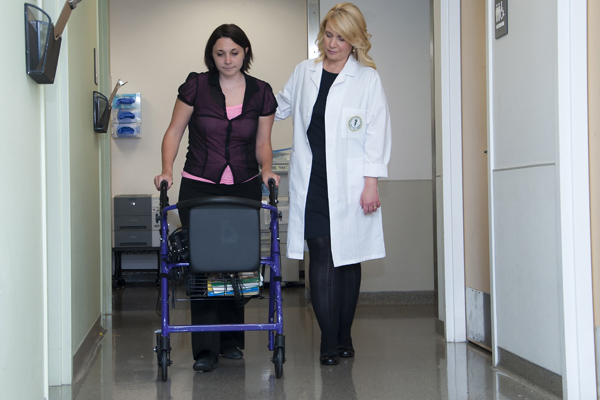
Results of the Edison EPI-743 trial are expected later next year. In the meantime, Hanson continues to move forward, refusing to let a disease stop her. For the third consecutive year, she was among the patients who spoke Sept. 5 at the 5th Annual USF-FARA Scientific Symposium — sharing their stories of living as optimistically as possible with Friedreich’s ataxia.
“You only have one life, and everyone has a burden to bear. You either laugh about it or you cry about it – and I’m done crying,†she said. “I’m trying to be as happy as I can be.â€
See related story: USF/FARA scientific symposium to share latest advances in ataxia research

Photos by Aimee Blodgett, USF Communications and Marketing
]]>